| Srl | Item |
| 1 |
ID:
055055


|
|
|
| 2 |
ID:
187033
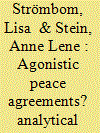

|
|
|
|
|
| Summary/Abstract |
Later years have seen the growth of a vibrant theoretical discussion on agonistic peace and the importance of creating space for contestation, plurality, and dissensus post-accord. However, there has been very few attempts at embedding agonistic theory in empirical analyses of peace agreements. This study attends to that lacuna by investigating how agonistic principles can be integrated and investigated in peace agreements. We suggest a threefold set of indicators for assessing the degree to which peace agreements are invested with agonistic dynamics: (1) what types of spaces for interaction are offered post-accord; (2) what forms of inclusion are stipulated; and (3) how is the peace agreement framed in terms of conflict termination and consensus/dissensus? We illustrate how the various indicators could be put into motion in concrete analyses applying them to examples from the Oslo Accords, the Belfast Agreement, and the Colombian Peace Agreement. Finally, we discuss four dilemmas and problematiques of integrating agonistic ideas in peace agreements; the issue of power, the mixing of agonistic and liberal ideals in peace agreements, the principle of ‘nothing is agreed until everything is agreed’ and the related double-edged potential of constructive ambiguity and finally the challenges of implementing peace agreements.
|
|
|
|
|
|
|
|
|
|
|
|
|
|
|
|
| 3 |
ID:
061984
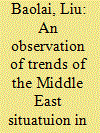

|
|
|
| 4 |
ID:
059690
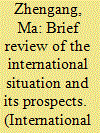

|
|
|
| 5 |
ID:
059598
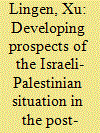

|
|
|
| 6 |
ID:
068239
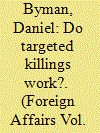

|
|
|
| 7 |
ID:
082403
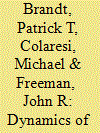

|
|
|
|
|
| Publication |
2008.
|
| Summary/Abstract |
Do public opinion dynamics play an important role in understanding conflict trajectories between democratic governments and other rival groups? The authors interpret several theories of opinion dynamics as competing clusters of contemporaneous causal links connoting reciprocity, accountability, and credibility. They translate these clusters into four distinct Bayesian structural time series models fit to events data from the Israeli-Palestinian conflict with variables for U.S. intervention and Jewish public opinion about prospects for peace. A credibility model, allowing Jewish public opinion to influence U.S., Palestinian, and Israeli behavior within a given month, fits best. More pacific Israeli opinion leads to more immediate Palestinian hostility toward Israelis. This response's direction suggests a negative feedback mechanism in which low-level conflict is maintained and momentum toward either all-out war or dramatic peace is slowed. In addition, a forecasting model including Jewish public opinion is shown to forecast ex ante better than a model without this variable
|
|
|
|
|
|
|
|
|
|
|
|
|
|
|
|
| 8 |
ID:
066944
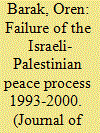

|
|
|
| 9 |
ID:
068740
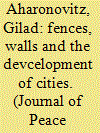

|
|
|
| 10 |
ID:
051573


|
|
|
| 11 |
ID:
052898
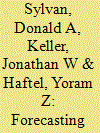

|
|
|
| 12 |
ID:
020062
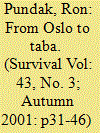

|
|
|
|
|
| Publication |
2001.
|
| Description |
p31-46
|
|
|
|
|
|
|
|
|
|
|
|
|
|
|
|
| 13 |
ID:
078066
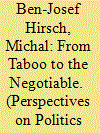

|
|
|
|
|
| Publication |
2007.
|
| Summary/Abstract |
In the last round of the Israeli-Palestinian peace talks at the Taba Conference (January 2001), Israeli negotiators went where no Israeli officials went before: they considered the right of return of Palestinian refugees, and a quasi-statement that acknowledges the Palestinian tragedy and Israel's share of historical responsibility. This paper argues that at least in part this shift in the negotiations' framework can be traced back to the public debate instigated by the work of Israeli New Historians
|
|
|
|
|
|
|
|
|
|
|
|
|
|
|
|
| 14 |
ID:
052899
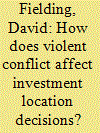

|
|
|
| 15 |
ID:
062175
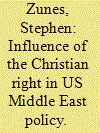

|
|
|
| 16 |
ID:
050075
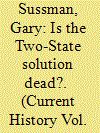

|
|
|
| 17 |
ID:
056271
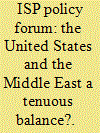

|
|
|
| 18 |
ID:
078785
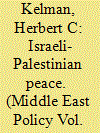

|
|
|
| 19 |
ID:
068767
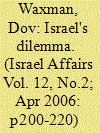

|
|
|
| 20 |
ID:
051416
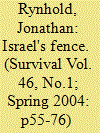

|
|
|
|
|
| Publication |
2004.
|
| Description |
p55-76
|
| Summary/Abstract |
Israel's security barrier is under construction and it is likely to be finished, so arguments about whether it should be built at all are pretty much academic. Far more important now is the nature and route of the barrier. Routes that go too deep into West Bank territory, that cut off and isolate Palestinian villages and encompass remote Israeli settlements are indeed likely to heighten the Palestinians' humiliation, harm them economically, and provoke worsened violence and terrorism. But other routes, closer to the ‘Green Line’, could exert more positive influence, not least because they would logically entail the abandonment of unviable settlements. A sensibly routed barrier has the potential not only to help protect Israelis from terrorists, but also to make a broader strategic contribution as a mechanism for managing the conflict and as a back-up plan as the prospects for a formal agreement fade.
|
|
|
|
|
|
|
|
|
|
|
|
|
|
|
|